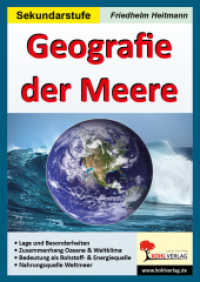- ホーム
- > 洋書
- > 英文書
- > Business / Economics
基本説明
Analyses of the 'Green Revolution', technological and chemical advances from an economists perspective.
Full Description
The questions of population growth and food supply have long been of central concern to economists. The World Food Economy seeks to examine the lessons of the past for wealthy nations, where agricultural output has steadily risen for decades, as well as for developing nations where the advances of the "Green Revolution" in the 1960s have introduced new problems in addition to solutions. This text assesses the challenge of satisfying food demand during the twenty-first century as consumers and producers in every part of the world—rich and poor alike—feel the effects of expanded global commodity trade, food aid, and national legislation in response to globalization.
Examines increases in agricultural output and productivity in both the developed and developing worlds
Analyzes the centrality of agricultural development to general economic progress and explores cases where governments attempt to foster economic expansion while neglecting food production
Assesses the challenge of satisfying food demand during the twenty-first century, given the effects of globalization on international trade and national legislation.
Contents
Preface. Acknowledgements.
Part I: Introduction.
1.1 Our Focus.
1.2 Chapter Outline.
Study Questions.
Part II: The Demand Side: How Population Growth and Higher Incomes Affect Food Consumption.
2.1 Classic Malthusianism, its Modern Variants, and its Critiques.
2.2 Demographic Transition.
2.3 Trends in Human Numbers, Past and Present.
2.4 Food Consumption and Income.
2.5 Demand Trends and Projections.
2.6 Summary and Conclusions.
Study Questions.
Appendix: The Fundamental Economics of Demand.
Part III: The Supply Side: Agricultural Production and its Determinants.
3.1 The Nature of Agriculture.
3.2 Increases in Agricultural Supply.
3.3 Has Intensification Run its Course?.
3.4 Trends in Per-Capita Consumption.
Study Questions.
Appendix: The Fundamental Economics of Supply.
Part IV: Aligning the Consumption and Production of Food over Time.
4.1 The Desirability of Competitive Equilibrium.
4.2 The Market Impacts of Commodity Programs.
4.3 Historical Trends in the Scarcity of Agricultural Products.
4.4 Outlook for the Twenty-First Century.
Study Questions.
Appendix: The Coordination of Decentralized Decision-Making.
Part V: Agriculture and the Environment.
5.1 Environmental Trade-Offs.
5.2 Market Failure.
5.3 Environmental Deterioration in the Absence of Agricultural Intensification.
5.4 Agricultural Development and the Environment.
Study Questions.
Part VI: Globalization and Agriculture.
6.1 The Theory of Comparative Advantage.
6.2 The Net Costs of Trade Distortions.
6.3 The Debate over Globalization.
6.4 Agricultural Trade: Recent Trends and the Current Debate.
6.5 Why Not More Trade?.
Study Questions.
Appendix: A Two-Country Illustration of Comparative Advantage.
Part VII: Agriculture and Economic Development.
7.1 Growth and Economic Structure.
7.2 Agriculture's Role in Economic Development.
7.3 Trying to Develop at Agriculture's Expense.
7.4 Agricultural Development for the Sake of Economic Growth and Diversification.
7.5 Summary and Conclusions.
Study Questions.
Part VIII: Striving for Food Security.
8.1 What is Food Security?.
8.2 Who and Where Are the Food-Insecure?.
8.3 Achieving Food Security.
8.4 The Food Security Synthesis and Economic Development.
8.5 The Standard Model, Communitarian Values, and Economic Equity.
Study Questions.
Part IX: A Synopsis of Regional Trends in the Global Food Economy.
9.1 Economic Growth and Income Distribution.
9.2 Population Dynamics.
9.3 Agriculture's Response to Demand Growth.
9.4 Summary.
Study Questions.
Tables.
Part X : Affluent Nations.
10.1 Standards of Living.
10.2 Population Dynamics.
10.3 The Food Economy.
10.4 Dietary Change and Consumption Trends.
10.5 Summary.
Study Questions.
Tables.
Part XI: Asia.
11.1 Trends in GDP per Capita.
11.2 Population Dynamics.
11.3 Agricultural Development.
11.4 Dietary Change, Consumption Trends, and Food Security.
11.5 Summary.
Study Questions.
Tables.
Part XII: Latin America and the Caribbean.
12.1 Trends in GDP per Capita.
12.2 Population Dynamics.
12.3 Agricultural Development.
12.4 Dietary Change, Consumption Trends, and Food Security.
12.5 Summary.
Study Questions.
Tables.
Part XIII: Middle East and North Africa.
13.1 Trends in GDP per Capita.
13.2 Population Dynamics.
13.3 Agricultural Development.
13.4 Dietary Change, Consumption Trends, and Food Security.
13.5 Summary.
Study Questions.
Tables.
Part XIV: Eastern Europe and the Former Soviet Union.
14.1 Patterns of Economic Growth since the Fall of Communism.
14.2 Demographic Trends.
14.3 The Agricultural Sector.
14.4 Dietary Change, Consumption Trends, and Food Security.
14.5 Summary.
Study Questions.
Tables.
Part XV: Sub-Saharan Africa.
15.1 Trends in GDP per Capita.
15.2 Demographic Trends.
15.3 Agricultural Development.
15.4 Consumption Trends and Food Security.
15.5 Summary.
Study Questions.
Tables.
Part XVI: The Food Economy in the Twenty-First Century.
16.1 Victims of Our Own Success?.
16.2 The New Food Economy.
16.3 The Changing Role of Government.
Study Questions.
Abbreviations and Acronyms.
Map Annex.
References.
Index








